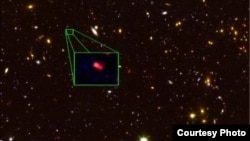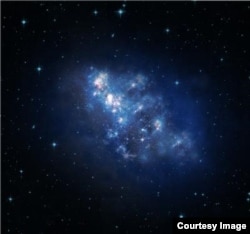Astronomers have discovered what they’re calling the most distant galaxy ever found.
A team from the University of Texas at Austin says the galaxy is so far away that the observed light is from just 700 million years after the Big Bang.
The galaxy, known as z8_GND_5296, is some 30 billion light-years from Earth.
“We want to study very distant galaxies to learn how galaxies change with time, which helps us understand how the Milky Way came to be,” said Steven Finkelstein who led the team.
Another member of the team, Casey Papovich of Texas A&M University, said the galaxy offers a “glimpse of conditions when the universe was only about 5 percent of its current age of 13.8 billion years.”
Astronomers measure the distance of galaxies by looking at the so-called “redshift.” Since the universe is expanding, light gets stretched making objects look more red.
Z8_GND_5296 has a redshift of 7.51, the largest measured. The previous record holder had a redshift of 7.2.
The galaxy is also forming stars extremely rapidly — producing stars at a rate 150 times as fast as our own Milky Way galaxy.
“So we’re learning something about the distant universe,” Finkelstein said. “There are way more regions of very high star formation than we previously thought.”
Although observations with NASA’s Hubble Space Telescope have identified many other candidates for galaxies in the early universe, including some that might perhaps be even more distant, this galaxy is the farthest and earliest whose distance can be definitively confirmed with follow-up observations from the Keck I telescope, one of a pair of the world’s largest Earth-bound telescopes.
The paper will be will be published in the October 24 issue of the journal Nature.
A team from the University of Texas at Austin says the galaxy is so far away that the observed light is from just 700 million years after the Big Bang.
The galaxy, known as z8_GND_5296, is some 30 billion light-years from Earth.
“We want to study very distant galaxies to learn how galaxies change with time, which helps us understand how the Milky Way came to be,” said Steven Finkelstein who led the team.
Another member of the team, Casey Papovich of Texas A&M University, said the galaxy offers a “glimpse of conditions when the universe was only about 5 percent of its current age of 13.8 billion years.”
Astronomers measure the distance of galaxies by looking at the so-called “redshift.” Since the universe is expanding, light gets stretched making objects look more red.
Z8_GND_5296 has a redshift of 7.51, the largest measured. The previous record holder had a redshift of 7.2.
The galaxy is also forming stars extremely rapidly — producing stars at a rate 150 times as fast as our own Milky Way galaxy.
“So we’re learning something about the distant universe,” Finkelstein said. “There are way more regions of very high star formation than we previously thought.”
Although observations with NASA’s Hubble Space Telescope have identified many other candidates for galaxies in the early universe, including some that might perhaps be even more distant, this galaxy is the farthest and earliest whose distance can be definitively confirmed with follow-up observations from the Keck I telescope, one of a pair of the world’s largest Earth-bound telescopes.
The paper will be will be published in the October 24 issue of the journal Nature.








